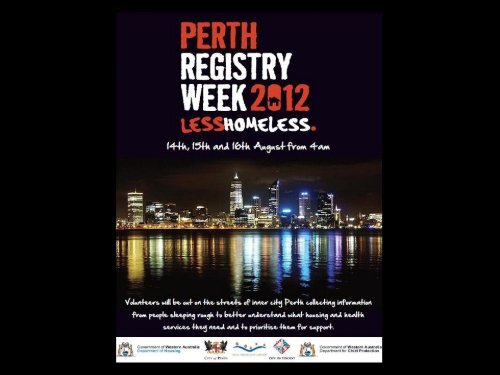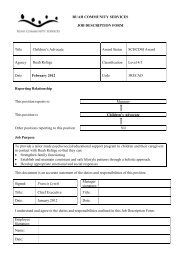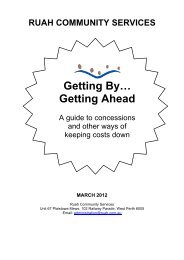Vulnerability Index - Ruah Community Services
Vulnerability Index - Ruah Community Services
Vulnerability Index - Ruah Community Services
- No tags were found...
You also want an ePaper? Increase the reach of your titles
YUMPU automatically turns print PDFs into web optimized ePapers that Google loves.
<strong>Vulnerability</strong> <strong>Index</strong><strong>Vulnerability</strong> <strong>Index</strong>• Based on Dr. Jim O’Connell’s research with Boston’s Healthcarefor the Homeless• Ranks individuals by mortality risk and length of homelessness• Has been used in Registry Week events and now on an ongoingbasis in Brisbane, Sydney, Melbourne and Hobart
<strong>Vulnerability</strong> <strong>Index</strong>• More than 6 months street homeless AND at least one of the following:– End Stage Renal Disease– History of Cold Weather Injuries– Liver Disease or Cirrhosis– HIV+/AIDS– Over 60 years old– Three or more emergency room visits in prior three months– Three or more ER or hospitalisations in prior year– Tri-morbid (mentally ill+ abusing substances+ medical problem)• Under 25 risk factors– Alcohol everyday in past 30– HIV+/AIDS– Injection Drug Use
Project Overview• Pre-Registry Week preparation, liaison with EasternStates and planning.• Funded by City of Perth, DOH/DCP, City of Vincentand <strong>Ruah</strong>• Steering Committee & Project Working Group• Training for team leaders and volunteers: Sun 12 andMon 13• Registry week event :13 – 17 August• Data input 14, 15, 16 August
Project Overview• Area covered: City of Perth/City of Vincent• 9 teams: over 80 volunteer; 13 Police officers; 8Salvation Army volunteers• Surveyed in public spaces, drop in centres and soupvans• Project Working Group identified known hot spots• Teams allocated particular areas to cover over 3 days
Interview Methodology• Each person encountered: VI survey completed andphoto (written consent)• $10 for participating• Breakfast packs and sleeping bags provided• 158 agreed to complete survey (29 refusals) = 84%response rate• 120 agreed to photo
Interview Questions• Demographics• Health Risk Indicators• Institutional Usage (prison, hostels, police cells)• ER and hospital inpatient useage• Employment, Benefits, and Citizenship• Photo• What they need to make them feel safe and well (openended question)
Interview Results• 185 people found on the streets, in squats, bushland, daycentres and at soup patrols• 158 (85%) homeless adults surveyed• Nyoongar Patrol involved to ensure adequate Aboriginalperspective• Anglicare involved for the youth perspective
Where are people sleeping?• 111 (70%) are rough sleepers (including streets, cars,squats etc)• 10 (6%) are couch surfing• 19 (12%) are in crisis accommodation (boarding housesand shelters)
‘Vulnerable’ Individuals - Mortality Risk• 93 (59%) with high mortality risk (vulnerable)‘Vulnerable’ are people who have at least 1 mortality risk factor, rankordered by their length of homelessness• 3 people with 6 vulnerability factors
Prevalence of Mortality Risk Indicators for Perth surveyRisk Indicator # %# Surveyed 158 100%Frostbite/Immersion Foot 22 14%HIV-AIDS Cases 4 3%Kidney Cases 15 9%Liver Cases 21 13%3X ED or more in 3 months 33 21%3X ED or Inpatient in 1 year 47 30%TriMorbid 55 35%Age 60 years or older 8 5%
• 45 people (28%) reported having been homeless for more than 10 years
Age/Seniors• Average age 37 years old (national average of 41 years old)• 13 (8%) people are over 55 years old• Oldest respondent was 73 years old (a veteran, more than 5 yearshomeless and in poor health)
Youth• 37 respondents were under 25 years old (23%)• 50% of young people under 25 are ‘vulnerable’ (18 people)• 50% of young people under 25 had been in foster care or anotherinstitution (18)• Youngest respondent was 13 years old
This chart is for Capital City data only, for other areas:• Townsville 88% Aboriginal, 9% Torres Strait Islander• Western Sydney 26% Aboriginal, 1% Torres Strait Islander
• 76(48%) respondents report IV drug use• 62(32%) respondents report drinking every day for past 30 days•79 (50%) Dually diagnosed
ER & Inpatient HospitalisationsEmergency Department Presentations in past 3 months:• 73 people had 278 presentations• A total cost of $156,514 for the past 3 months(based on average cost of ED presentation)Inpatient hospital admissions in past year:• 81 people had 260 admissions• Total cost $1.48 million per year(based on an average cost per stay for hospitalisation)($5686 per admission Metro Health <strong>Services</strong> Annual Report 2010-11 x = $1.478,360)($563 Metropolitan Health Service Annual Report 2010-11 x278 =$156,514)
Institutional History• 51 (32%) of respondents reported history of foster care,institutional care or other child protection• 119 (75%) respondents reported having been in police cells• 97 (61%) respondents reported having been to prisonsCost per day of keeping an offender in Custody WA (2010-11 $291.51) , Dept Corrective <strong>Services</strong> Annual Report 2010-11ABS – Prisoners in Australia 2011 - Median sentence length Western Australia 2.8 years$297,923 per person x 97 people $28.9
Violent Crime and Brain InjuryViolent Crime90 (57%) report being a victim of a violent attack sincebecoming homelessBrain Injury52 (33%) report suffering from a brain injury
Breaking it into smaller chunks93 Vulnerable6 people with 5 or more vulnerability indicators8 Seniors over 6037 Youth under 2558 Indigenous44 Women2 Transgender8 Veterans
Next Steps• Identify follow on collaborative actions includingcommunity engagement• <strong>Ruah</strong>, MCOT and Mobile GP immediately identify themost vulnerable and develop follow up plan• Build momentum for housing and support for peopleon the vulnerability list• Continue to complete VIs for all new contacts roughsleeping• Follow up strategy for all people surveyed
We asked the question what do you need to bewell and safe…
















